agar firdaus bar-rū-e-zamīñ ast
hamīñ ast o hamīñ ast o hamīñ ast
If there is a parardise on the face of the earth.
It is here, it is here, it is here.
-Amir Khusro
Narrative
The above mentioned couplet is inscribed in the inner corner arches of Diwan-e-Khas on the north and the south in Qila Mubarak. This couplet is popularly ascribed to Amir Khusro. This couplet was never meant for Kashmir as Khusro never visited it.
Qila Mubarak or the “Auspicious Fortress” is popularly referred to as the “Lal Qila” or the Red Fort. It was built by Emperor Shahjahan in the 17th century, adjacent to Salimgarh that was built by Islam Shah Suri in 1546 C.E. The former is connected to the latter via a bridge. Together they form the Red Fort complex.
The fort contains four large gateways, two small entrances, and twenty-one towers (seven round and fourteen octagonal). The gate in the direction of Salimgarh in the north, the gate above the Jharokah-i Darshan in the east, the Lahori gate in the west and the Akbarbadi Gate in the south formed the four large gateways.
A road ran from the Salimgarh gate in the north to the Akbarbadi gate in the south that divided the fort complex into two halves: the western side (city side) and the eastern side (river side). The southern half of the eastern side contained the Harem.
The Qila includes various structures: Chhatta Chowk, Naqqar Khanah, Daulat Khanah, Asad Burj, Jahanara Begum’s Mansion, Imtiaz Mahal/ Rang Mahal, Jharokah-i Darshan, Daulat Khanah-i-Khas, Hammam, Moti Masjid, Shah Burj, Hayat Bakhsh Garden, Mahtab Bagh, Khuwabgah, Musamman Burj, Hira Mahal, Sawan and Bhadon pavilions, Zafar Mahal and Tank.
Architecture
Salimgarh It was constructed by Islam Shah or Salim Shah of the Sur dynasty in 1546 C.E. It is polygonal in shape bounded by a solid rubble masonry wall interspersed with several bastions. The North Western Railways now uses it to get access to the old railway station at chandini chowk. It is now a part of red fort complex.
References
a. https://www.rekhta.org/
b. Blake, Stephen P. “Cityscape of an Imperial Capital : Shahjahanabad in 1739”.
c. “Monuments of Delhi: Lasting Splendour of the Great Mughals and Others. Volume I Shahjahanabad.”1997.
d. https://whc.unesco.org/en/list/231/
e. Safvi, Rana. “ Shahjahanabad: The Living City Of Old Delhi”. 2019.

